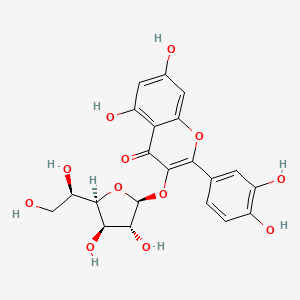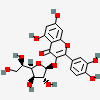Isoquercitrin
- 21637-25-2
- Isotrifolin
- Isoquercitroside
- 3-(((2S,3R,4R,5R)-5-((R)-1,2-Dihydroxyethyl)-3,4-dihydroxytetrahydrofuran-2-yl)oxy)-2-(3,4-dihydroxyphenyl)-5,7-dihydroxy-4H-chromen-4-one
- 0YX10VRV6J
- Create:2005-08-08
- Modify:2025-01-04

- 2-(3,4-dihydroxyphenyl)-3-(beta-D-glucofuranosyloxy)-5,7-dihydroxy-4H-1-benzopyran-4-one
- 4H-1-benzopyran-4-one, 2-(3,4-dihydroxyphenyl)-3-(beta-D-glucofuranosyloxy)-5,7-dihydroxy
- flavone, 3,3',4',5,7-pentahydroxy-, 3-beta-D-glucofuranoside
- isoquercetin
- isoquercitin
- isoquercitrin
- isoquercitroside
- isotrifoliin
- quercetin 3-(beta-D-glucofuranoside)
- quercetin 3-O-beta-D-glucofuranoside
- quercetin-3-glucoside
- quercetin-3-O-beta-glucoside
- quercetin-3-O-glucoside
- trifoliin
- trifoliin A
- 21637-25-2
- Isotrifolin
- Isoquercitroside
- 3-(((2S,3R,4R,5R)-5-((R)-1,2-Dihydroxyethyl)-3,4-dihydroxytetrahydrofuran-2-yl)oxy)-2-(3,4-dihydroxyphenyl)-5,7-dihydroxy-4H-chromen-4-one
- 0YX10VRV6J
- CCRIS 7093
- 3,3',4',5,7-Pentahydroxyflavone 3-beta-D-glucofuranoside
- EINECS 244-488-5
- quercetin 3-O-beta-D-glucofuranoside
- UNII-0YX10VRV6J
- FEMA NO. 4225
- CHEBI:28299
- DTXSID80904976
- 4H-1-Benzopyran-4-one, 2-(3,4-dihydroxyphenyl)-3-(beta-D-glucofuranosyloxy)-5,7-dihydroxy-
- Flavone, 3,3',4',5,7-pentahydroxy-, 3-beta-D-glucofuranoside
- 2-(3,4-Dihydroxyphenyl)-3-(beta-D-glucofuranosyloxy)-5,7-dihydroxy-4H-1-benzopyran-4-one
- 2-(3,4-dihydroxyphenyl)-5,7-dihydroxy-4-oxo-4H-chromen-3-yl beta-D-glucofuranoside
- C21H20O12
- BIDD:PXR0033
- SCHEMBL24608
- OPJZLUXFQFQYAI-GNPVFZCLSA-N
- DTXCID101334095
- Quercitin-3-beta-D-glucofuranoside
- HY-N0768
- MFCD29050128
- quercetin 3-(beta-D-glucofuranoside)
- AKOS027257412
- 3-[(2S,3R,4R,5R)-5-[(1R)-1,2-dihydroxyethyl]-3,4-dihydroxyoxolan-2-yl]oxy-2-(3,4-dihydroxyphenyl)-5,7-dihydroxychromen-4-one
- BS-15919
- ISOQUERCETIN ENZYMATICALLY MODIFIED
- 1ST156859
- CS-0009793
- NS00050387
- Isoquercitrin (Isoquercitroside; Isoquercetin)
- QUERCETIN 3-(.BETA.-D-GLUCOFURANOSIDE)
- QUERCETIN 3-O-.BETA.-D-GLUCOFURANOSIDE
- Q27103621
- FLAVONE, 3,3',4',5,7-PENTAHYDROXY-, 3-.BETA.-D-GLUCOFURANOSIDE
- 4H-1-benzopyran-4-one, 2-(3,4-dihydroxyphenyl)-3-(beta-D-glucofuranosyloxy)-5,7-dihydroxy
- 4H-1-BENZOPYRAN-4-ONE, 2-(3,4-DIHYDROXYPHENYL)-3-(.BETA.-D-GLUCOFURANOSYLOXY)-5,7-DIHYDROXY-
Not Classified
Reported as not meeting GHS hazard criteria by 2 of 2 companies. For more detailed information, please visit ECHA C&L website.
Aggregated GHS information provided per 2 reports by companies from 1 notifications to the ECHA C&L Inventory.
Reported as not meeting GHS hazard criteria per 2 of 2 reports by companies. For more detailed information, please visit ECHA C&L website.
There are 0 notifications provided by 0 of 2 reports by companies with hazard statement code(s).
Information may vary between notifications depending on impurities, additives, and other factors. The percentage value in parenthesis indicates the notified classification ratio from companies that provide hazard codes. Only hazard codes with percentage values above 10% are shown.
- CAS Common ChemistryLICENSEThe data from CAS Common Chemistry is provided under a CC-BY-NC 4.0 license, unless otherwise stated.https://creativecommons.org/licenses/by-nc/4.0/
- ChemIDplusChemIDplus Chemical Information Classificationhttps://pubchem.ncbi.nlm.nih.gov/source/ChemIDplus
- DrugBankLICENSECreative Common's Attribution-NonCommercial 4.0 International License (http://creativecommons.org/licenses/by-nc/4.0/legalcode)https://www.drugbank.ca/legal/terms_of_useIsoquercitrinhttps://www.drugbank.ca/drugs/DB16403
- EPA DSSToxIsoquercitrinhttps://comptox.epa.gov/dashboard/DTXSID80904976CompTox Chemicals Dashboard Chemical Listshttps://comptox.epa.gov/dashboard/chemical-lists/
- European Chemicals Agency (ECHA)LICENSEUse of the information, documents and data from the ECHA website is subject to the terms and conditions of this Legal Notice, and subject to other binding limitations provided for under applicable law, the information, documents and data made available on the ECHA website may be reproduced, distributed and/or used, totally or in part, for non-commercial purposes provided that ECHA is acknowledged as the source: "Source: European Chemicals Agency, http://echa.europa.eu/". Such acknowledgement must be included in each copy of the material. ECHA permits and encourages organisations and individuals to create links to the ECHA website under the following cumulative conditions: Links can only be made to webpages that provide a link to the Legal Notice page.https://echa.europa.eu/web/guest/legal-notice2-(3,4-dihydroxyphenyl)-3-(β-D-glucofuranosyloxy)-5,7-dihydroxy-4H-1-benzopyran-4-onehttps://echa.europa.eu/substance-information/-/substanceinfo/100.040.4292-(3,4-dihydroxyphenyl)-3-(β-D-glucofuranosyloxy)-5,7-dihydroxy-4H-1-benzopyran-4-one (EC: 244-488-5)https://echa.europa.eu/information-on-chemicals/cl-inventory-database/-/discli/details/120990
- FDA Global Substance Registration System (GSRS)LICENSEUnless otherwise noted, the contents of the FDA website (www.fda.gov), both text and graphics, are not copyrighted. They are in the public domain and may be republished, reprinted and otherwise used freely by anyone without the need to obtain permission from FDA. Credit to the U.S. Food and Drug Administration as the source is appreciated but not required.https://www.fda.gov/about-fda/about-website/website-policies#linking
- ChEBIQuercetin 3-O-beta-D-glucofuranosidehttps://www.ebi.ac.uk/chebi/searchId.do?chebiId=CHEBI:28299
- LOTUS - the natural products occurrence databaseLICENSEThe code for LOTUS is released under the GNU General Public License v3.0.https://lotus.nprod.net/3-(((2S,3R,4R,5R)-5-((R)-1,2-Dihydroxyethyl)-3,4-dihydroxytetrahydrofuran-2-yl)oxy)-2-(3,4-dihydroxyphenyl)-5,7-dihydroxy-4H-chromen-4-onehttps://www.wikidata.org/wiki/Q27103621LOTUS Treehttps://lotus.naturalproducts.net/
- Yeast Metabolome Database (YMDB)Quercetin 3-O-glucosidehttps://www.ymdb.ca/compounds/YMDB01778
- EPA Chemical and Products Database (CPDat)EPA CPDat Classificationhttps://www.epa.gov/chemical-research/chemical-and-products-database-cpdat
- Japan Chemical Substance Dictionary (Nikkaji)
- Metabolomics Workbench
- NCI Thesaurus (NCIt)LICENSEUnless otherwise indicated, all text within NCI products is free of copyright and may be reused without our permission. Credit the National Cancer Institute as the source.https://www.cancer.gov/policies/copyright-reuseNCI Thesaurushttps://ncit.nci.nih.gov
- NORMAN Suspect List ExchangeLICENSEData: CC-BY 4.0; Code (hosted by ECI, LCSB): Artistic-2.0https://creativecommons.org/licenses/by/4.0/NORMAN Suspect List Exchange Classificationhttps://www.norman-network.com/nds/SLE/
- PharosLICENSEData accessed from Pharos and TCRD is publicly available from the primary sources listed above. Please respect their individual licenses regarding proper use and redistribution.https://pharos.nih.gov/aboutIsoquercitrinhttps://pharos.nih.gov/ligands/ZVDLZK3KP6H8
- Wikidataisoquercitrinhttps://www.wikidata.org/wiki/Q27103621
- PubChem
- Medical Subject Headings (MeSH)LICENSEWorks produced by the U.S. government are not subject to copyright protection in the United States. Any such works found on National Library of Medicine (NLM) Web sites may be freely used or reproduced without permission in the U.S.https://www.nlm.nih.gov/copyright.htmlisoquercitrinhttps://www.ncbi.nlm.nih.gov/mesh/67016527
- GHS Classification (UNECE)GHS Classification Treehttp://www.unece.org/trans/danger/publi/ghs/ghs_welcome_e.html
- MolGenieMolGenie Organic Chemistry Ontologyhttps://github.com/MolGenie/ontology/

